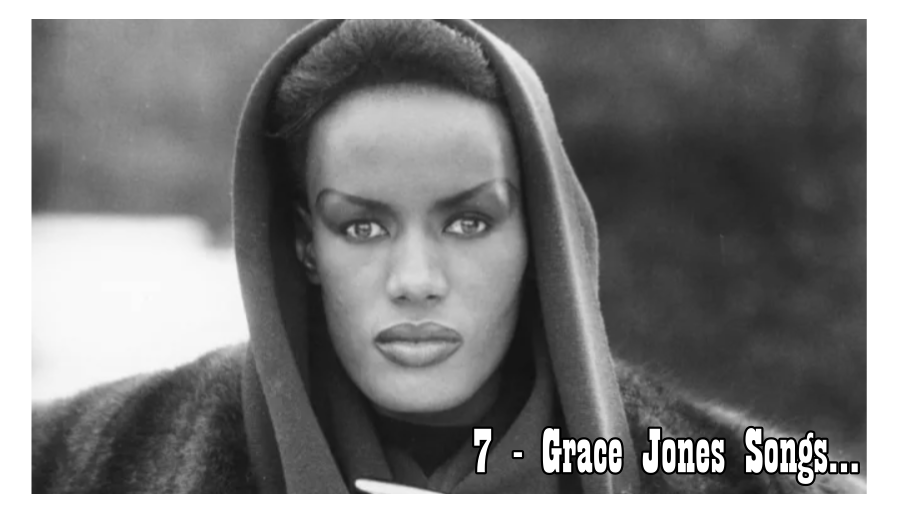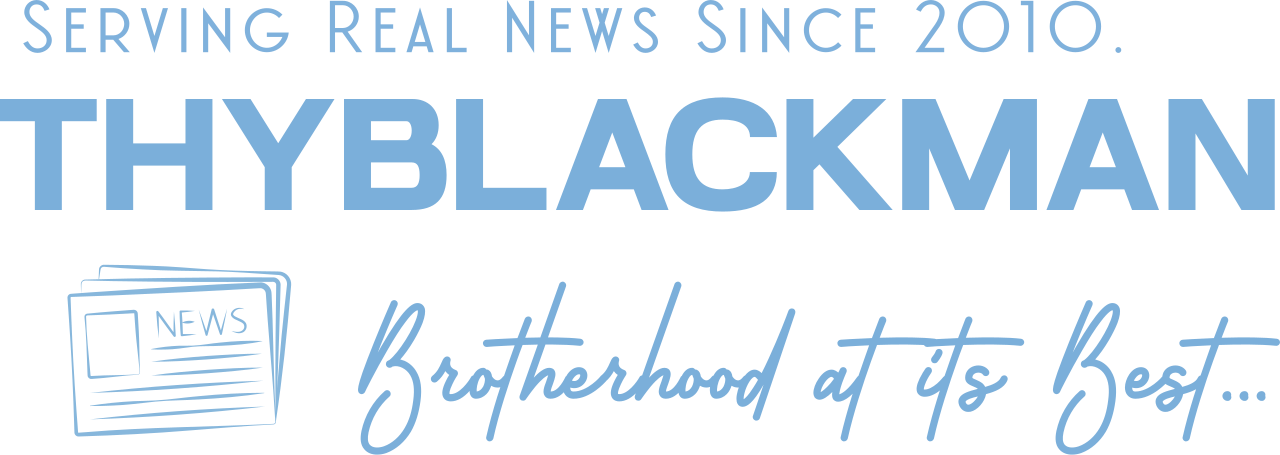(ThyBlackMan.com) Grace Jones has always been one of those artists you don’t just listen to—you experience her. The first time I heard her voice, it stopped me in my tracks. Deep, confident, and unapologetically different, it felt like she was singing from another world entirely—one where art, fashion, gender, and sound collided to form something bold and beautiful. Jones never chased trends; she created them.
If you’ve ever been curious about her music but didn’t know where to start, or if you’ve only heard the name but never explored her catalog, these seven songs are a perfect introduction. Each one captures a different side of her—from tender and vulnerable to fierce and untouchable. They’re not just tracks; they’re moments in time, wrapped in attitude, rhythm, and innovation. These songs remind us that Grace Jones wasn’t built to fit into a box—she was born to shatter them.

1. “Pull Up to the Bumper”
Grace Jones’ “Pull Up to the Bumper” is as provocative as it is funky. Off her critically-acclaimed Nightclubbing album, the track is built on a steely, reggae-infused groove that never lets up. With its infectious guitar riff, staccato rhythm, and sly double entendre, it’s one of her most accessible songs—but don’t mistake accessibility for simplicity. It’s layered, sly, and incredibly well-produced, thanks to the Compass Point All Stars, whose sound gave Jones her musical backbone during this era.
What makes this track a standout, even beyond the beat, is the lyrical cheekiness that Grace Jones delivers with a raised eyebrow and a knowing smirk. The title alone is a metaphor wrapped in innuendo—“pull up to my bumper, baby, in your long black limousine”—but Jones doesn’t sing it with overt lust; instead, she imbues it with swagger and control. It’s flirtation on her terms, and the line between seduction and dominance is razor-thin. Her cool delivery is ice on fire—dispassionate on the surface, but smoldering underneath.
Even today, the song remains a club favorite. DJs often spin it in retro sets, queer spaces, and dance parties because of its unapologetic attitude and dance-floor-ready swagger. The androgynous power Jones projects in the video and live performances only heightens the track’s cultural significance. It wasn’t just a hit—it was a declaration of sexual independence, personal freedom, and defiance of pop norms. The production, rooted in reggae rhythms with funk and disco flourishes, creates a timeless groove that’s still sampled and covered to this day.
“Pull Up to the Bumper” continues to sound fresh thanks to its minimal but effective arrangement. The interplay between percussion and guitar lines invites movement, and Grace’s delivery—cool, detached, yet cheekily expressive—feels as if it were designed to transcend generations. Whether you’re blasting it in a retro-themed party or discovering it through a vinyl treasure hunt, it still grooves with power. It’s a song that dares you to dance, dares you to look closer, and dares you to redefine how sexy music can sound when laced with wit and power.
2. “Slave to the Rhythm”
This song is arguably one of Grace Jones’ most theatrical and grand statements. “Slave to the Rhythm” is not just a song—it’s an experience. Produced by Trevor Horn, the track is a masterclass in art-pop, layering spoken word segments, backup vocals, and orchestral crescendos into a mesmerizing sonic landscape. It plays like an audio biography, capturing Jones’ image as both a fashion warrior and avant-garde musical force. It’s simultaneously danceable and philosophical—club-ready and cerebrally rich.
Musically, it’s a marvel. There’s an elegance in the production that creates dramatic tension with every beat. You get an orchestra, layered vocal samples, a relentless rhythm track, and Jones’ voice moving between spoken narration and commanding chants. Horn’s complex soundscaping makes this less a pop single and more a piece of sonic architecture. It’s cinematic and theatrical without being overwrought, and Jones commands every element like a conductor in full regalia.
Lyrically, the song deals with themes of performance, identity, and being consumed by the act of creation. “A slave to the rhythm” becomes both a celebration and a warning, and Jones’ voice—intimidating and hypnotic—rides that fine line perfectly. Her delivery evokes a ritualistic tone, as if she’s summoning the listener into a world where time and genre are fluid. It’s a meta-commentary on her own life as an entertainer, woman, and icon in an industry built on image and endurance.
Even now, the track feels cinematic and avant-garde. With today’s resurgence of experimental pop and boundary-pushing visuals in artists like FKA twigs, Rina Sawayama, or Janelle Monáe, “Slave to the Rhythm” feels eerily prophetic. It’s a sonic collage that still commands attention and should be studied for how pop can transcend into fine art. The song is a testament to what happens when form meets content in perfect harmony—when the beat is both the message and the medium.
3. “Warm Leatherette”
“Warm Leatherette” is a bold reinvention of a cult classic by The Normal, and Grace Jones took the song and molded it into something completely her own. Her cover strips the original’s lo-fi rawness and rebuilds it with angular guitar riffs, thick basslines, and a robotic vocal delivery that is equal parts cool and unhinged. It’s a defining moment in the post-punk meets new wave canon and a bold introduction to the sonic shift she embraced in the early ’80s.
Jones brings a tension to the track that’s almost erotic, industrial, and disturbing. The lyrical content—referencing a car crash and the violent intersection of technology and sexuality—feels like a commentary on modern life, especially as we become more entangled in machines. Her monotone vocals become a form of rebellion; it’s not apathetic—it’s calculated. She distances herself from emotion and instead embodies the machine—a chrome figure of destruction and allure. It’s not vulnerability she’s expressing—it’s dominance in a synthetic world.
What’s most intriguing is how well this song has aged. Its themes of dehumanization, mechanized intimacy, and dissociation mirror the realities of a modern world dominated by artificial intelligence, digital relationships, and online personas. “Warm Leatherette” could easily soundtrack a Black Mirror episode or a cyberpunk film. It’s cold, but never hollow. Instead, it vibrates with dystopian electricity—brilliant and unnerving.
The song resonates in our current age of digital alienation and fetishized technology. Contemporary artists who dabble in cyberpunk aesthetics or dystopian themes owe a debt to “Warm Leatherette.” It’s perfect listening for fans of noir synthscapes or anyone who loves music that challenges norms while delivering an unforgettable sonic punch. More than four decades later, Grace Jones’ version still feels like a glimpse into the future—and in many ways, it was.
4. “La Vie en Rose”
Grace Jones’ take on “La Vie en Rose” is a revelation. Taking a classic Edith Piaf chanson and turning it into a languid reggae ballad was a risky move, but it paid off spectacularly. The song opens slowly with a warm guitar, giving way to her mesmerizing vocals—smoky, sensual, and deeply intimate. It’s one of her most emotionally resonant tracks and highlights her versatility as a vocalist. It was also a bold move for a debut artist, establishing from the start that Jones would not be bound by expectation or genre convention.
The strength of this interpretation lies in how gently Jones reclaims the track. Unlike the theatrical posturing of her later work, “La Vie en Rose” is stripped down and sincere. There’s a subtle vulnerability here. Jones doesn’t overpower the lyrics; she lets them breathe and float over the groove. Her accent, timing, and tone offer a unique flavor to a song that’s been covered countless times. She owns it by not imitating Piaf but by offering a Caribbean dreamscape version that’s all her own. The warmth of the instrumentation, alongside her restrained performance, draws you in closer with each passing bar.
Decades later, this version remains as soothing and seductive as ever. It’s ideal for those quiet moments of reflection or romance—like the sonic equivalent of a slow sunset. What Jones captures here is not just the spirit of love but the intoxication of it. “La Vie en Rose” is timeless because it isn’t trying to be anyone else’s version—it’s hers, and in that ownership, it becomes a masterpiece of interpretation. Whether you’re falling in love or yearning for something lost, this rendition offers comfort like no other.
5. “Walking in the Rain”
Originally written and performed by Flash and the Pan, Jones’ version of “Walking in the Rain” becomes an anthem of alienation, attitude, and eerie glamour. Her deadpan delivery turns the mundane act of walking in the rain into something cinematic and noir-like. It’s another prime example of how she can take a song and transform it into an entirely new emotional experience. It’s not just a cover—it’s an act of transformation, where every pause and syllable is weaponized to create an atmosphere of cool detachment and mystery.
The production here is key—icy synths, reverb-heavy guitar, and a slow, pulsating rhythm make the track feel like you’re moving through a misty cityscape under dim neon lights. Jones’ presence looms large. She doesn’t just sing the lyrics; she inhabits them. “Feeling like a woman, looking like a man” becomes a profound declaration of gender fluidity long before it entered mainstream pop discourse. That single line, delivered in her trademark low register, is a manifesto of identity bending and unapologetic self-expression.
In 2025, this song feels especially current. As gender and identity conversations grow louder in art and society, “Walking in the Rain” acts like a spiritual ancestor to many of today’s gender-nonconforming and nonbinary artists. Play this while walking alone with headphones—it’s moody, empowering, and strangely comforting. The urban loneliness it conjures, the feeling of moving through the world on your own terms, makes it a perfect soundtrack for introspective nights. Grace doesn’t demand your attention here—she draws it through ambiance and restrained magnetism.
6. “I’ve Seen That Face Before (Libertango)”
This haunting track merges Astor Piazzolla’s tango composition “Libertango” with reggae elements and Jones’ icy vocals, creating a truly global fusion of sound. Sung partially in French, the song has a cinematic flair, often evoking images of dark alleys, smoky cafés, and cold gazes across crowded rooms. It’s noir pop at its finest. The brilliance lies in its ability to transport the listener into an emotional and geographical setting that feels both European and Caribbean, sophisticated and eerie.
Grace Jones tells the story of a mysterious figure she keeps seeing over and over again. Her delivery—cool, observant, tinged with suspicion—perfectly matches the tension in the music. The strings stab like glances, the beat pulses like footsteps, and the accordion adds a layer of melancholy elegance. It’s storytelling through ambiance. The track pulses with unease, like a psychological thriller. And it’s all held together by Grace, who never breaks her emotional armor—but still lets the cracks show through her haunting restraint.
Today, this song holds up as a masterclass in genre fusion. It’s the kind of track that feels right at home in a David Lynch film or on a late-night playlist for brooding thinkers. Artists who explore mood as a central theme—like The Weeknd or Roísín Murphy—owe a stylistic nod to what Grace Jones accomplished here. The track is mysterious, exotic, and unforgettable. You don’t just listen to “I’ve Seen That Face Before”—you enter it. You dwell inside it for a while and emerge changed, slightly off-balance but entirely captivated.
7. “Nipple to the Bottle”
“Nipple to the Bottle” is one of Jones’ most groove-heavy tracks and also one of her most biting. With its funky bassline, jagged guitar, and hypnotic rhythm, it’s a scathing critique of dependency and excess. Whether about alcohol, fame, or emotional neediness, the song warns against crutches and illusions with the kind of directness only Grace Jones could deliver. It’s confrontational, yet danceable—a combination only Jones could pull off with such confidence and style.
Co-written with Sly Dunbar, the track showcases her reggae roots, but the funk and dance influence make it incredibly danceable. Jones’ vocals are sharp, sometimes sarcastic, sometimes seething. She spits lines like mantras, turning every phrase into a warning shot. The track is also rhythmically relentless—drums snap, basslines roll, and guitar riffs slice through the mix. It’s music with muscle, meant to move your body while shaking up your mind.
In an age of wellness trends, detox culture, and a reevaluation of addiction narratives, “Nipple to the Bottle” feels more relevant than ever. It questions not just physical dependencies, but emotional ones too. Jones dares the listener to examine what they reach for in moments of weakness—whether it’s a substance, a person, or a distraction. It’s a song that can be listened to on the dancefloor or in deep reflection, depending on your mood. Either way, it hits hard. And like much of Jones’ best work, it leaves you thinking long after the beat fades out.
Listening to Grace Jones is like walking into a room full of mirrors—you see versions of strength, sensuality, rebellion, and vulnerability staring back at you. These seven songs only scratch the surface of her artistry, but they offer a powerful glimpse into what makes her one of the most captivating figures in music history.
Even today, her sound still feels ahead of its time. Whether you’re dancing alone in your living room, strolling through a rain-drenched city, or just reflecting on life, Grace Jones has a song that fits the moment. So if you haven’t already, give these tracks a listen—not just with your ears, but with your full attention. You might find a part of yourself in them.
Staff Writer; Jamar Jackson

















Leave a Reply